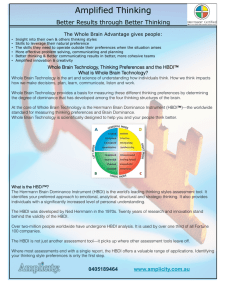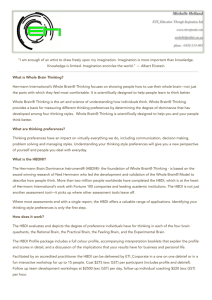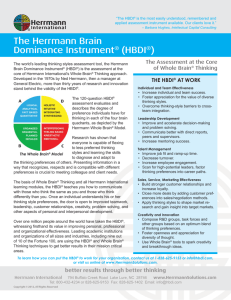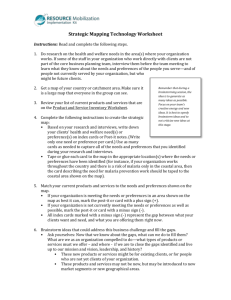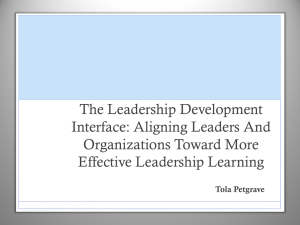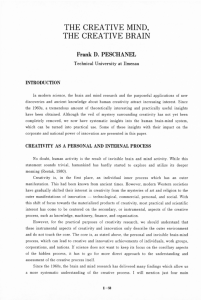CE14 Whole Brain Thinking
advertisement
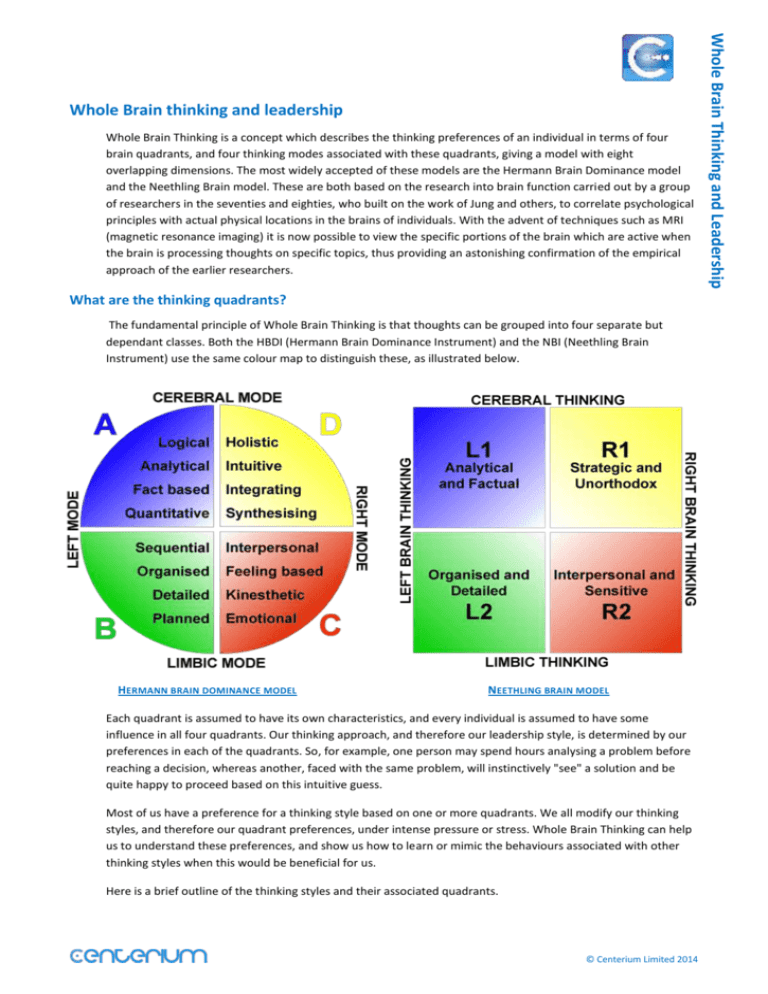
Whole Brain Thinking is a concept which describes the thinking preferences of an individual in terms of four brain quadrants, and four thinking modes associated with these quadrants, giving a model with eight overlapping dimensions. The most widely accepted of these models are the Hermann Brain Dominance model and the Neethling Brain model. These are both based on the research into brain function carried out by a group of researchers in the seventies and eighties, who built on the work of Jung and others, to correlate psychological principles with actual physical locations in the brains of individuals. With the advent of techniques such as MRI (magnetic resonance imaging) it is now possible to view the specific portions of the brain which are active when the brain is processing thoughts on specific topics, thus providing an astonishing confirmation of the empirical approach of the earlier researchers. What are the thinking quadrants? The fundamental principle of Whole Brain Thinking is that thoughts can be grouped into four separate but dependant classes. Both the HBDI (Hermann Brain Dominance Instrument) and the NBI (Neethling Brain Instrument) use the same colour map to distinguish these, as illustrated below. HERMANN BRAIN DOMINANCE MODEL NEETHLING BRAIN MODEL Each quadrant is assumed to have its own characteristics, and every individual is assumed to have some influence in all four quadrants. Our thinking approach, and therefore our leadership style, is determined by our preferences in each of the quadrants. So, for example, one person may spend hours analysing a problem before reaching a decision, whereas another, faced with the same problem, will instinctively "see" a solution and be quite happy to proceed based on this intuitive guess. Most of us have a preference for a thinking style based on one or more quadrants. We all modify our thinking styles, and therefore our quadrant preferences, under intense pressure or stress. Whole Brain Thinking can help us to understand these preferences, and show us how to learn or mimic the behaviours associated with other thinking styles when this would be beneficial for us. Here is a brief outline of the thinking styles and their associated quadrants. © Centerium Limited 2014 Whole Brain Thinking and Leadership Whole Brain thinking and leadership Whole Brain Thinking and Leadership GREEN Quadrant – Leading with Control Characteristics Controlled Conservative Planner Organisational Administrative Leadership Focus is on: Achieving task goals Setting and maintaining standards Managing boundaries Monitoring performance Accessing and applying resources Providing structure Leaders using this style: Structure and schedule Monitor and assess Plan and resource Measure and review M ARGARET THATCHER They say things like: My responsibility is to get results, achieve tasks and deliver to target. The leader is the guardian of quality, standards and performance. Leaders using this style prefer to: Develop operational plans and goals Rehearse and refine improvement processes Apply on-going review skills Manage time and resources effectively Meet deadlines Benchmark results Maintain high levels of discipline and compliance Pay attention to details HERMIONE GRAINGER © Centerium Limited 2014 Whole Brain Thinking and Leadership BLUE Quadrant – Leading with Reason Logical Analyzer Mathematical Technical Problem Solver Leadership focus is on: Analysing information and situations Understanding cause and effect Evaluating options Building business cases and rationales Making well-judged decisions Rational problem-solving Leaders using this style: SIR ISAAC NEWTON Analyse and understand Conclude and theorise Evaluate and judge Criticise and challenge They say things like: Leadership is about selecting the right strategy and knowing why it is right. Separate reason and emotion: follow the head not the heart. Leaders using this style prefer to: Create and present compelling and convincing arguments Build and explain the ‘background’ theory to support their decisions Demonstrate structured and logical problem-solving processes Assess and select appropriate levels of risk Criticise and evaluate strategic options Make full use of organisational knowledge and information MR SPOCK © Centerium Limited 2014 Whole Brain Thinking and Leadership RED Quadrant – Leading with Empathy Interpersonal Emotional Musical Spiritual Talker Leadership focus is on: Sharing values to create a culture Adhering to beliefs and principles Being authentic and valuing people Building relationships Open, honest communication Leaders using this style: Nurture and support Trust and empower Coach and develop Respect and value PRINCESS DIANA They say things like: People matter: leadership is about the people who follow. Be clear about your values, principles and beliefs and stand up for them. Leaders using this style need to: Use active and reflective listening skills Demonstrate a high level of self-awareness Be consistent in their own behaviour Create a climate of trust and support Offer and receive feedback Coach others to develop performance Stand up for their followers Allow mistakes as part of a learning process Talent-spot and nurture potential M OTHER TERESA © Centerium Limited 2014 Whole Brain Thinking and Leadership YELLOW Quadrant – Leading with Vision Imaginative Synthesizer Artistic Holistic Conceptualiser Leadership focus is on: Looking to the future Creating and sharing vision Making new connections Exploring possibilities Responding to ‘leader’s instinct’ Generating excitement M K GHA NDI Leaders using this style: Excite and inspire Explore and experiment Imagine and foresee Change and adapt M A R TI N LU THE R KI NG They say things like: Just because it works, doesn’t mean we can’t do better. Let’s imagine the world we want, then go out and create it. Leaders using this style prefer to: Demonstrate personal enthusiasm and passion Sell ideas with confidence and conviction Challenge perceived restrictions and limitations: ask “What if?” Demonstrate ‘big picture’ thinking Encourage risk-taking and ambiguity Encourage multiple options Network with others: look beyond the organisation V A CLA V HA V E L © Centerium Limited 2014 Thinking preferences affect virtually everything you do, including your communication, decision-making, problem-solving and managing styles. Understanding your thinking style preferences will give you a new perspective on yourself and people you deal with every day. How can thinking preferences be determined? The Hermann Brain Dominance Instrument (HBDI) is an assessment tool for this. The Neethling Brain Instrument (NBI) is another. Between them they are used by over 60% of the US Fortune 200 companies, and about the same proportion of top European companies. These tools identify your preferred approach to emotional, analytical, structural and strategic thinkingby asking a series of questions. Your answers to these are compared to known standards to give a preference "map" like the one below. How does it work? The HBDI is capable of isolating and measuring the strength of preference for each of the four distinct thinking parts of the brain. These consist of the left and right cerebral hemispheres and the left and right halves of the limbic system. The two left side structures combine to represent what is popularly called "left brain" thinking. The two right side structures combine to represent "right brain" thinking. The two cerebral structures combine to represent cerebral thinking and the two limbic structures combine to represent limbic thinking. The HBDI, through its series of 120 questions, is capable of measuring the degree of preference between each of the four individual thinking structures (quadrants) and each of the four paired structures (modes) . This results in a four quadrant profile, which displays the degree of preference for each of the four quadrants - your HBDI profile. Scoring results are free of value judgement and cultural bias. Because it is a self-analysis, most people immediately recognise their results as accurate. What does it mean for me? Firstly, once you have examined and understood your thinking preferences, you can relate these preferences to the types of decision you make and your leadership style, both at work and an outside work. You can make a conscious effort to understand the other types of thinking, and make allowances in your own thinking for the differences you will now understand better. Secondly, you can examine the thinking styles within any team of which you are a part, and learn to compensate for or support thinking areas in which the team is least strong. For example, if a team consists entirely of people with only a strong "Green" or "control" tendency, they will generally be able to monitor and control any task or project assigned to them to a very high level, but will struggle to innovate, or to motivate the people they work with. A team of all "Yellow" or "imaginative" people could come up with a new idea every day, but would be unlikely to have the ability to put any of these ideas into action. © Centerium Limited 2014 Whole Brain Thinking and Leadership What are your thinking preferences?


